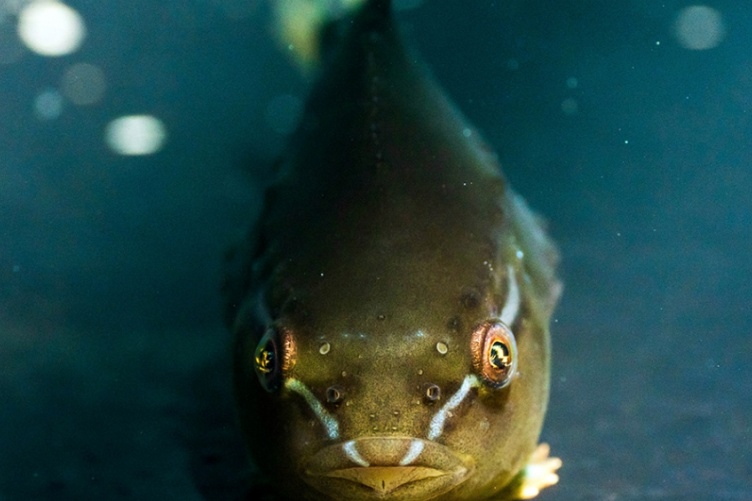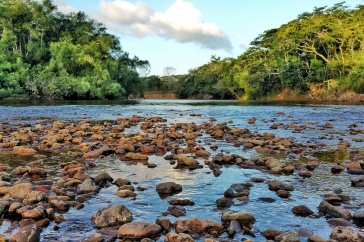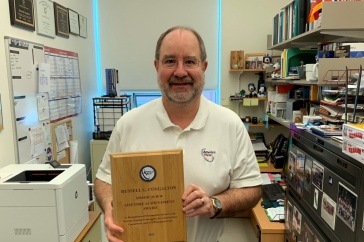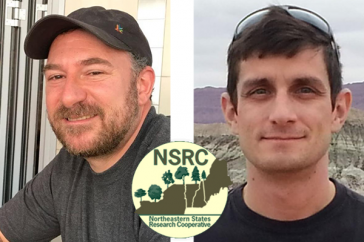
Using lumpfish as cleanerfish – fish that eat parasites off other fish – may be a sustainable way to manage sea lice. Credit: Tim Briggs/UNH

producing multiple batches of lumpfish in the Coastal Marine
Laboratory to demonstrate that lumpfish culture is feasible.
Credit: Tim Briggs/UNH
Sea lice negatively impact the health and survival of Atlantic salmon, steelhead trout, and other salmonids. Researchers with the New Hampshire Agricultural Experiment Station at the University of
New Hampshire believe using lumpfish as cleanerfish – fish that eat parasites off other fish – may be a sustainable way to manage these pests.
“Lumpfish eat parasites off salmonids farmed in cages in nearshore coastal waters in the northern Atlantic Ocean. Sea lice are a naturally occurring parasite that feed off fish mucus, skin, and blood. They cause open wounds on the fish, and in the worst cases, kill them. As a result, mitigating sea lice can be very costly to fish farming operations,” said Elizabeth Fairchild, experiment station researcher and research associate professor of biological sciences.
“We are evaluating the use of lumpfish as ‘biological delousers’ on salmonid farms in the United States. Cleanerfish are used in all countries where salmonids are farmed in the northern Atlantic Ocean except in the United States,” Fairchild said.
By using lumpfish, Fairchild aims to support a more sustainable way to manage sea lice infestations on salmonid farms and increase domestic salmonid production. Sea lice currently are managed by exposing the salmonids to thermal baths on a boat, which can be stressful and harmful to the fish, and not effective over the long run. Prior to these baths, environmentally harmful pesticides were used. These chemicals have been banned in the United States.
“We should eat more seafood for our own health, and we can and should increase our domestic seafood production. Using cleanerfish to decrease the damage inflicted by sea lice can increase domestic salmonid production because more farm sites can be used and used more frequently. Today many leased sites in Maine are not used or sit fallow for extended periods because of historically high sea lice concentrations,” Fairchild said.
“In addition, new business opportunities would be created if lumpfish can benefit domestic salmonid farms. Salmon farmers will need to source lumpfish from hatcheries and grow-out facilities, a market that does not exist right now,” she said.
The work is important given that in 2017, the United States had a $16.8 billion seafood trade deficit, meaning it imported more seafood than it exported. More than 90 percent of the seafood Americans consume is imported, and more than half of the imported seafood is farmed. Moreover, Atlantic salmon tops the list of imported fish.

abilities with steelhead trout in a series of field experiments, including
tracking the behaviors of lumpfish and trout in a small farm.
Credit: Tim Briggs/UNH
In addition, Maine soon will be the only state in the USA with Atlantic salmon production. In New Hampshire, steelhead trout are cage-cultured through NH Sea Grant and UNH. At least one commercial farm is seeking permits to grow steelhead trout in New Hampshire waters.
At the UNH Judd Gregg Marine Research Complex, researchers are producing multiple batches of lumpfish in the Coastal Marine Laboratory to demonstrate that lumpfish culture is feasible. Graduate and undergraduate students are conducting experiments to improve lumpfish culture methods by evaluating larval and juvenile fish nutrition, tank stocking density, tank designs, and fish behavior.
This summer, Fairchild and her lab plan to assess lumpfish cleaning abilities with steelhead trout in a series of field experiments, including tracking the behaviors of lumpfish and trout in a small farm. Some lumpfish and trout will be tagged with acoustic transmitters, which will allow researchers to map, in three dimensions, where the fish spend their time in the sea cage. The movement patterns of the fish will be correlated to current, daylight, depth, and water temperature to understand how these variables affect cage utilization and delousing abilities. This will result in guidelines for how to effectively integrate lumpfish into steelhead trout farms.
Collaborators include researchers with the University of Maine Center for Cooperative Aquaculture Research, USDA National Cold Water Marine Aquaculture Center, Memorial University of Newfoundland, Cooke Aquaculture USA, Cooke Aquaculture LLC, and Blue Water Fisheries LLC. The findings will be shared via an e-book and a series of workshops at salmonid farms and aquaculture meetings are planned. Some of the research has been presented at Aquaculture America 2020.
This material is based upon work supported by the NH Agricultural Experiment Station, through joint funding of the National Institute of Food and Agriculture, U.S. Department of Agriculture, under award number 1017317, and the state of New Hampshire. Additional support is provided by the Northeastern Regional Aquaculture Center, NH Sea Grant, and the UNH Marine Biology Graduate Program.
Founded in 1887, the NH Agricultural Experiment Station at the UNH College of Life Sciences and Agriculture is UNH’s original research center and an elemental component of New Hampshire's land-grant university heritage and mission. We steward federal and state funding, including support from the USDA National Institute of Food and Agriculture, to provide unbiased and objective research concerning diverse aspects of sustainable agriculture and foods, aquaculture, forest management, and related wildlife, natural resources and rural community topics. We maintain the Woodman and Kingman agronomy and horticultural research farms, the Macfarlane Research Greenhouses, the Fairchild Dairy Teaching and Research Center, and the Organic Dairy Research Farm. Additional properties also provide forage, forests, and woodlands in direct support to research, teaching, and outreach.
The University of New Hampshire is a flagship research university that inspires innovation and transforms lives in our state, nation, and world. More than 16,000 students from all 50 states and 71 countries engage with an award-winning faculty in top ranked programs in business, engineering, law, liberal arts, and the sciences across more than 200 programs of study. UNH’s research portfolio includes partnerships with NASA, NOAA, NSF, and NIH, receiving more than $100 million in competitive external funding every year to further explore and define the frontiers of land, sea, and space.
-
Written By:
Lori Tyler Gula, Ph.D., '19 | NH Agricultural Experiment Station | lori.gula@unh.edu | 603-862-1452




















































